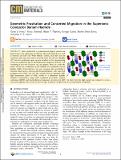Files in this item
Geometric frustration and concerted migration in the superionic conductor barium hydride
Item metadata
| dc.contributor.author | Irvine, Gavin J. | |
| dc.contributor.author | Demmel, Franz | |
| dc.contributor.author | Playford, Helen | |
| dc.contributor.author | Carins, George M. | |
| dc.contributor.author | Jones, Martin | |
| dc.contributor.author | Irvine, John T. S. | |
| dc.date.accessioned | 2022-11-08T17:30:20Z | |
| dc.date.available | 2022-11-08T17:30:20Z | |
| dc.date.issued | 2022-11-22 | |
| dc.identifier | 281877604 | |
| dc.identifier | e879aba2-c295-494e-a365-48852188cefe | |
| dc.identifier | 85141694819 | |
| dc.identifier | 000883004500001 | |
| dc.identifier.citation | Irvine , G J , Demmel , F , Playford , H , Carins , G M , Jones , M & Irvine , J T S 2022 , ' Geometric frustration and concerted migration in the superionic conductor barium hydride ' , Chemistry of Materials , vol. 34 , no. 22 , pp. 9934–9944 . https://doi.org/10.1021/acs.chemmater.2c01995 | en |
| dc.identifier.issn | 0897-4756 | |
| dc.identifier.other | ORCID: /0000-0002-8394-3359/work/122719752 | |
| dc.identifier.uri | https://hdl.handle.net/10023/26335 | |
| dc.description | Funding: Authors would like to thank the ISIS Facility Development Studentship for funding this work. Additionally, I would like to thank ISIS Neutron and Muon Source for providing the beam time to collect all the scattering data presented in this paper. Finally, I would like to thank the Crockett Scholarship for supporting my studies. For the purpose of open access, the author has applied a Creative Commons Attribution (CC BY) license to any Accepted Author Manuscript version arising. | en |
| dc.description.abstract | Ionic conductivity is a phenomenon of great interest, not least because of its application in advanced electrochemical devices such as batteries and fuel cells. While lithium, sodium, and oxide fast ion conductors have been the subjects of much study, the advent of hydride (H–) ion fast conductors opens up new windows in the understanding of fast ion conduction due to the fundamental simplicity of the H– ion consisting of just two electrons and one proton. Here we probe the nature of fast ion conduction in the hydride ion conductor, barium hydride (BaH2). Unusually for a fast ion conductor, this material has a structure based upon a close-packed hexagonal lattice, with important analogues such as BaF2 and Li2S. We elucidate how the structure of the high temperature phase of BaH2 results in a disordered hydride sublattice. Furthermore, using novel combined quasi-elastic neutron scattering (QENS) and electrochemical impedance spectroscopy (EIS) we show how the high energy ions interact to create a concerted migration that results in macroscopic superionic conductivity via an interstitialcy mechanism. | |
| dc.format.extent | 11 | |
| dc.format.extent | 5202044 | |
| dc.language.iso | eng | |
| dc.relation.ispartof | Chemistry of Materials | en |
| dc.subject | QD Chemistry | en |
| dc.subject | NDAS | en |
| dc.subject | MCC | en |
| dc.subject.lcc | QD | en |
| dc.title | Geometric frustration and concerted migration in the superionic conductor barium hydride | en |
| dc.type | Journal article | en |
| dc.contributor.sponsor | Science & Technology Facilities Council | en |
| dc.contributor.institution | University of St Andrews. School of Chemistry | en |
| dc.contributor.institution | University of St Andrews. Centre for Energy Ethics | en |
| dc.contributor.institution | University of St Andrews. Centre for Designer Quantum Materials | en |
| dc.contributor.institution | University of St Andrews. EaSTCHEM | en |
| dc.identifier.doi | 10.1021/acs.chemmater.2c01995 | |
| dc.description.status | Peer reviewed | en |
| dc.identifier.grantnumber | STFC : 5005 | en |
This item appears in the following Collection(s)
Items in the St Andrews Research Repository are protected by copyright, with all rights reserved, unless otherwise indicated.

